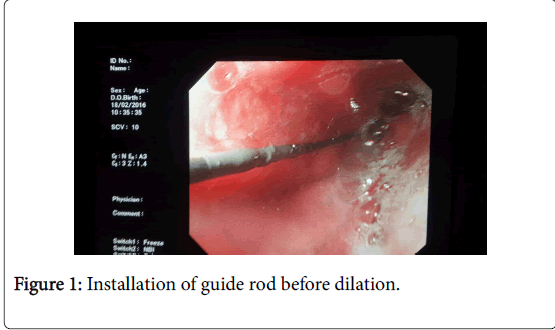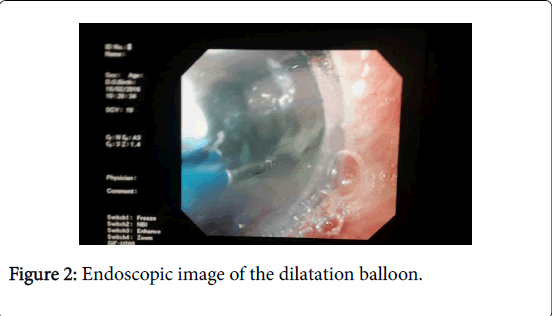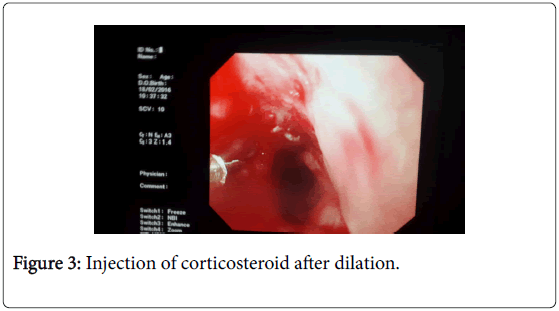Case Report Open Access
Interest of Corticosteroid Injection in Refractory Benign Stenosis of the Esophagus
Aomari A*, Seddik H and Benkirane A
Department of Hepato-gastroenterology II, Military Hospital Mohamed V, Rabat, Morocco
- *Corresponding Author:
- Aomari A
Department of Hepato-gastroenterology II
Military Hospital Mohamed V, Rabat, Morocco
Tel: 2120653656377
E-mail: Ayoub.medinterne@gmail.com
Received date: June 16, 2017; Accepted date: June 28 2017; Published date: June 30, 2017
Citation: Aomari A, Seddik H, Benkirane A (2017) Interest of Corticosteroid Injection in Refractory Benign Stenosis of the Esophagus. J Gastrointest Dig Syst 7:514. doi:10.4172/2161-069X.1000514
Copyright: © 2017 Aomari A, et al. This is an open-access article distributed under the terms of the Creative Commons Attribution License, which permits unrestricted use, distribution, and reproduction in any medium, provided the original author and source are credited.
Visit for more related articles at Journal of Gastrointestinal & Digestive System
Abstract
The post-surgical anastomotic oesophageal stenosis is usually benign, which may recur rapidly after several endoscopic dilations (refractory stenosis). The purpose of this work is to show, through an observation, the interest
of the injection of the corticoids during the endoscopic treatment of refractory oesophageal stenosis. It was a patient who benefited from an esophagectomy of 2/3 inferior+oeso-gastric anastomosis after ingestion of hydrochloric acid (spirit of salt).
The evolution was marked by the installation of a post-anastomotic stenosis recurring after several sessions of endoscopic dilations. The local injection of the corticosteroids (Triamcinolone) at the time of the dilation sessions, allowed a decrease in the frequency of the dilatations, a disappearance of the dysphagia, an improvement of the general state with a weight gain. The injection of corticosteroids was a good solution for this patient, to avoid endoscopic treatment failures, and to improve her quality of life.
Keyword
Oesophageal stenosis; Injection of corticosteroids
Introduction
The post-surgical anastomotic oesophageal stenosis are usually benign, requiring one to three dilation sessions to achieve a longlasting functional result,but sometimes these stenosis can recur rapidly after 5 sessions of endoscopic dilation (refractory stenosis).
The purpose of this work is to show, through an observation, the interest of the injection of the corticosteroids during the endoscopic treatment of refractory oesophageal stenosis.
Case Report
Patient, 60 years old, with no pathological history, admitted to the emergency room of the Military Hospital of Rabat for the management of a upper gastrointestinal bleeding (hematemesis) after accidental ingestion of 150 ml hydrochloric acid (the spirit of salt).
The oeso-gastro duodenal fibroscopy showed an ulceration in the mouth of Killian, with some necrosis ranges 17-18 cm from the dental arches; (Stage IIIa), associated with antral ulceration (stage II), and bulbar and duodenal ulcerations (DI, DII) (Stage II). An esophagectomy of the lower 2/3rd of the esophagus+oesogastric anastomosis was indicated in the patient. The evolution was marked by the installation of dysphagia, with a short anastomotic stenosis at 16 cm from the dental arches to gastroscopy.
The patient received 8 sessions of endoscopic dilations with always a rapid recurrence of the dysphagia (less than a month of interval) with alteration of the general state.The local injection of corticosteroids (Triamcinolone, Kenacort® 40 mg/ml diluted, 0.5 ml/quadrant) at the upper pole of the stenosis at the time of dilation (Figures 1-3) allowed an extension of the interval between 2 dilations, a decrease in the frequency of these dilations and a marked improvement in the general state with weight gain (Table 1).
| Parameters | Before injection of corticosteroids | After injection of corticosteroids |
|---|---|---|
| Weight | 45 kg | 66 kg |
| Dysphagia | Important solid +/- liquid | Not dysphagia |
| Interval between dilations | 3 weeks | 8 weeks |
| Number of dilations | 8 weeks | 3 sessions |
| Anorexia+asthenia | Present | Absent |
Table 1: Evolution of parameters after injection of corticosteroids.
Discussion
The endoscopic treatment of benign stenosis of the esophagus is indicated only in symptomatic cases (dysphagia, odynophagia, etc.). This is based on dilation. Currently, the dilation is carried out under endoscopic and possibly radiological control either by Savary-guillard bougies or by hydrostatic balloon. Usually, one to three dilation sessions are required to achieve a lasting functional outcome.The refractory stenosis is a recurrent symptomatic stenosis after 5 sessions of endoscopic dilatation [1,2]. In this situation, different endoscopic techniques can be proposed (endoprosthesis, local injection of corticosteroids, incision).
Their choice is based on the local experience of the endoscopy team and the morphological aspect of the stenosis. The use of local injection of corticosteroids in the treatment of cutaneous scars, keloids or not, has been described since 1960. In the esophagus, it is combined at the same time with dilation. In practice, triamcinolone (40 mg/ml diluted) is injected 4 or 8 points from 0.5 to 1 ml using a 23 G needle. The injections are performed at the upper pole of the stenosis. The supposed mechanism of action involves an inhibition of the local inflammatory response that reduces the production of collagen. Due to the much localized nature of the injections, it is likely that the results are better for short stenosis. With this technique, Kochhar et al. in a study of 71 patients with benign stenosis of various causes, showed an extension of the interval between two dilations and a decrease in the frequency of these dilations [3-5]. These data from the literature are identical to the results obtained in the patient of our study.
Conclusion
The endoscopic dilations represent the first-line treatment of benign stenosis of the esophagus. The local injection of corticosteroids is a good solution in cases of short refractory stenosis.
References
- SiersemaPD, de Wijkerslooth LRH (2009) Dilation of refractory benign strictures. GastrointestEndosc70:1000-1012.
- Kochman ML, McClave SA, Boyce HW (2005) The refractory and the recurrent esophageal stricture: A definition. GastrointestEndosc62:474-475.
- Kochhar R, Makharia GK (2002) Usefulness of intralesional triamcinolone in treatment of benign esophageal strictures. GastrintestEndosc56:29-34.
- Altintas E, Kacar S, Tunc B, Sezgin O, Parlak E, et al. (2004) Intralesional injection in benign esophageal strictures resistant to bougie dilation. J Gastroenterol Hepatol19:1388-1389.
- Ramage JI, Rumalla A, Baton TH,Pochron NL, Zinsmeister AR, et al. (2005) A prospective, randomized double-blind, placebo-controlled trial of endoscopic steroid injection therapy for recalcitrant esophageal peptic strictures. Am J Gastroenterol 100:2419-2425.
Relevant Topics
- Constipation
- Digestive Enzymes
- Endoscopy
- Epigastric Pain
- Gall Bladder
- Gastric Cancer
- Gastrointestinal Bleeding
- Gastrointestinal Hormones
- Gastrointestinal Infections
- Gastrointestinal Inflammation
- Gastrointestinal Pathology
- Gastrointestinal Pharmacology
- Gastrointestinal Radiology
- Gastrointestinal Surgery
- Gastrointestinal Tuberculosis
- GIST Sarcoma
- Intestinal Blockage
- Pancreas
- Salivary Glands
- Stomach Bloating
- Stomach Cramps
- Stomach Disorders
- Stomach Ulcer
Recommended Journals
Article Tools
Article Usage
- Total views: 2831
- [From(publication date):
June-2017 - Apr 05, 2025] - Breakdown by view type
- HTML page views : 2063
- PDF downloads : 768



